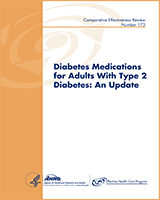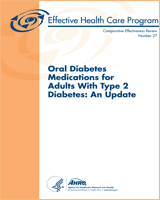NCBI Bookshelf. A service of the National Library of Medicine, National Institutes of Health.
This publication is provided for historical reference only and the information may be out of date.
Structured Abstract
Objectives:
Given the number of medications available for type 2 diabetes mellitus, clinicians and patients need information about their effectiveness and safety to make informed choices. The objective of this review was to summarize the benefits and harms of medications (metformin, second-generation sulfonylureas, thiazolidinediones, meglitinides, dipeptidyl peptidase-4 [DPP-4] inhibitors, and glucagon-like peptide-1 [GLP-1] receptor agonists), as monotherapy and in combination, for the treatment of adults with type 2 diabetes.
Data Sources:
We searched the MEDLINE, Embase, and Cochrane Central Register of Controlled Trials databases from inception through April 2010 for original English-language articles and sought unpublished data from the Food and Drug Administration and others.
Review Methods:
Two reviewers independently screened titles to identify studies that assessed intermediate outcomes (e.g., hemoglobin A1c [HbA1c]), long-term clinical outcomes (e.g., mortality), and harms (e.g., hypoglycemia) in head-to-head monotherapy or combination therapy comparisons. Two reviewers serially extracted data for each article using standardized protocols, assessed applicability, and independently evaluated study quality.
Results:
The review included 140 randomized controlled trials and 26 observational studies. We graded evidence as low or insufficient for long-term clinical outcomes of all-cause mortality, cardiovascular disease, nephropathy, and neuropathy. Most medications lowered HbA1c on average by 1 absolute percentage point, but metformin was more efficacious than the DPP-4 inhibitors. Two-drug combinations had similar HbA1c reduction. Compared with metformin, thiazolidinediones and sulfonylureas had a more unfavorable effect on weight (mean difference of +2.6 kg). Metformin decreased low density lipoprotein cholesterol relative to pioglitazone, sulfonylureas, and DPP-4 inhibitors. Sulfonylureas had a fourfold higher risk of mild/moderate hypoglycemia compared with metformin alone, and, in combination with metformin, had more than a fivefold increased risk compared with metformin plus thiazolidinediones. Thiazolidinediones had an increased risk of congestive heart failure relative to sulfonylureas and bone fractures relative to metformin. Diarrhea occurred more often for metformin compared with thiazolidinedione users.
Conclusions:
Comprehensive information comparing benefits and harms of diabetes medications can facilitate personalized treatment choices for patients. Although the long-term benefits and harms of diabetes medications remain unclear, the evidence supports use of metformin as a first-line agent. Comparisons of two-drug combinations showed little to no difference in HbA1c reduction, but some combinations increased risk for hypoglycemia and other adverse events.
Contents
- Preface
- Acknowledgments
- Technical Expert Panel
- Peer Reviewers
- Executive Summary
- Introduction
- Methods
- Results
- Search Results
- Key Question 1 In adults age 18 or older with type 2 diabetes mellitus, what is the comparative effectiveness of the treatment options (see list of comparisons) for the intermediate outcomes of glycemic control (in terms of HbA1c), weight, or lipids?
- Key Question 2 In adults age 18 or older with type 2 diabetes mellitus, what is the comparative effectiveness of the treatment options (see list of comparisons) in terms of the following long-term clinical outcomes?
- Key Question 3 In adults age 18 or older with type 2 diabetes mellitus, what is the comparative safety of the treatment options (see list of comparisons) in terms of the following adverse events and side effects?
- Key Question 4 Do safety and effectiveness of these treatment options (see list of comparisons) differ across subgroups of adults with type 2 diabetes, in particular for adults age 65 or older, in terms of mortality, hypoglycemia, cardiovascular and cerebrovascular outcomes?
- Quality Assessment
- Articles Reporting More Than One Study
- Discussion
- References
- Abbreviations
- Appendixes
- Appendix A Medication Comparisons
- Appendix B Detailed Electronic Database Search Strategies
- Appendix C Hand-Searched Journals
- Appendix D Forms
- Appendix E Tallies for Comparisons Not Included in Review
- Appendix F Excluded Articles
- Appendix G Evidence Tables
- Appendix H Summary of Updated Literature Search for Long-Term Clinical Trials (Number of Articles)
Update of Comparative Effectiveness Review No. 8, Comparative Effectiveness and Safety of Oral Diabetes Medications for Adults With Type 2 Diabetes, Including New Drug Classes and Two-Drug Combinations
Prepared for: Agency for Healthcare Research and Quality, U.S. Department of Health and Human Services1, Contract Number: 290-02-0018, Prepared by: Johns Hopkins University Evidence-based Practice Center, Baltimore, MD.
Suggested citation:
Bennett WL, Wilson LM, Bolen S, Maruthur N, Singh, S, Chatterjee R, Marinopoulos SS, Puhan MA, Ranasinghe P, Nicholson WK, Block L, Odelola O, Dalal DS, Ogbeche GE, Chandrasekhar A, Hutfless S, Bass EB, Segal JB. Oral Diabetes Medications for Adults With Type 2 Diabetes: An Update. Comparative Effectiveness Review No. 27. (Prepared by Johns Hopkins University Evidence-based Practice Center under Contract No. 290-02-0018.) AHRQ Publication No. 11-EHC038-EF. Rockville, MD: Agency for Healthcare Research and Quality. March 2011. Available at: www.effectivehealthcare.ahrq.gov/reports/final.cfm.
This report is based on research conducted by the Johns Hopkins University Evidence-based Practice Center under contract to the Agency for Healthcare Research and Quality (AHRQ), Rockville, MD (Contract No. 290-02-0018). The findings and conclusions in this document are those of the author(s), who are responsible for its content, and do not necessarily represent the views of AHRQ. No statement in this report should be construed as an official position of AHRQ or of the U.S. Department of Health and Human Services.
The information in this report is intended to help clinicians, employers, policymakers, and others make informed decisions about the provision of health care services. This report is intended as a reference and not as a substitute for clinical judgment.
This report may be used, in whole or in part, as the basis for the development of clinical practice guidelines and other quality enhancement tools, or as a basis for reimbursement and coverage policies. AHRQ or U.S. Department of Health and Human Services endorsement of such derivative products or actions may not be stated or implied.
None of the investigators have any affiliations or financial involvement that conflicts with the material presented in this report.
- 1
540 Gaither Road, Rockville, MD 20850; www
.ahrq.gov
- Review Comparative effectiveness and safety of medications for type 2 diabetes: an update including new drugs and 2-drug combinations.[Ann Intern Med. 2011]Review Comparative effectiveness and safety of medications for type 2 diabetes: an update including new drugs and 2-drug combinations.Bennett WL, Maruthur NM, Singh S, Segal JB, Wilson LM, Chatterjee R, Marinopoulos SS, Puhan MA, Ranasinghe P, Block L, et al. Ann Intern Med. 2011 May 3; 154(9):602-13. Epub 2011 Mar 14.
- Review AHRQ's comparative effectiveness research on oral medications for type 2 diabetes: a summary of the key findings.[J Manag Care Pharm. 2012]Review AHRQ's comparative effectiveness research on oral medications for type 2 diabetes: a summary of the key findings.Bennett WL, Balfe LM, Faysal JM. J Manag Care Pharm. 2012 Jan-Feb; 18(1 Suppl A):1-22.
- Review Diabetes Medications for Adults With Type 2 Diabetes: An Update[ 2016]Review Diabetes Medications for Adults With Type 2 Diabetes: An UpdateBolen S, Tseng E, Hutfless S, Segal JB, Suarez-Cuervo C, Berger Z, Wilson LM, Chu Y, Iyoha E, Maruthur NM. 2016 Apr
- Review Systematic review: comparative effectiveness and safety of oral medications for type 2 diabetes mellitus.[Ann Intern Med. 2007]Review Systematic review: comparative effectiveness and safety of oral medications for type 2 diabetes mellitus.Bolen S, Feldman L, Vassy J, Wilson L, Yeh HC, Marinopoulos S, Wiley C, Selvin E, Wilson R, Bass EB, et al. Ann Intern Med. 2007 Sep 18; 147(6):386-99. Epub 2007 Jul 16.
- Review Diabetes Medications as Monotherapy or Metformin-Based Combination Therapy for Type 2 Diabetes: A Systematic Review and Meta-analysis.[Ann Intern Med. 2016]Review Diabetes Medications as Monotherapy or Metformin-Based Combination Therapy for Type 2 Diabetes: A Systematic Review and Meta-analysis.Maruthur NM, Tseng E, Hutfless S, Wilson LM, Suarez-Cuervo C, Berger Z, Chu Y, Iyoha E, Segal JB, Bolen S. Ann Intern Med. 2016 Jun 7; 164(11):740-51. Epub 2016 Apr 19.
- Oral Diabetes Medications for Adults With Type 2 Diabetes: An UpdateOral Diabetes Medications for Adults With Type 2 Diabetes: An Update
Your browsing activity is empty.
Activity recording is turned off.
See more...

